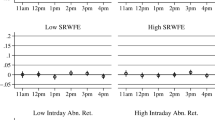Abstract
In this study, we investigate the relationship between information content of new product preannouncements (NPPAs) and trading behaviors of institutional investors. Using hand-collected data from 1995 to 2004, in empirical results, we find that there is a significantly positive relationship between information content and institutional investors. NPPAs can help institutional investors to evaluate the potential success of forthcoming new products through signaling enough information content. As a result, more information cues and earlier NPPAs can make institutional investors choose these preannouncing firms into their investment portfolios to increase their holdings and attract more different institutional investors to hold these shares of preannouncing firms. In addition, we also find the positive advertising and R&D investment effects. Our findings suggest that managers should use the information content of NPPA signals to reduce information asymmetry and help managers to implement their NPPA strategies so as to receive greater financial support from institutional investors.
Similar content being viewed by others
References
Ackert LF, Athanassakos G (2003) A simultaneous equations analysis of analysts’ forecast bias, analyst following, and institutional ownership. J Bus Financ Acc 30:1017–1041
Amihud Y, Li K (2006) The declining information content of dividend announcements and the effects of institutional holdings. J Financ Quant Anal 41:637–660
Andreas JM, Rapp MS, Wolff M (2012) Determinants of direct compensation in two-tier system: evidence from German panel data. Rev Manag Sci 6:33–79
Bergen M, Dutta S, Walker OC (1992) Agency relationships in marketing: a review of the implications and applications of agency and related theories. J Mark 56:1–24
Blume ME, Keim DB (2012) Institutional investors and stock market liquidity: trends and relationships. Working Paper, University of Pennsylvania
Busenitz LW, Fiet JO, Moesel DD (2005) Signaling in venture capitalist—new venture team funding decision: does it indicate long-term venture outcomes? Entrepreneurship Theory Pract 29:1–12
Bushee BJ (1998) The influence of institutional investors on myopic R&D investment behavior. Acc Rev 73:305–333
Calantone R, Schatzel K (2000) Strategic foretelling: communication-based antecedents of a firm’s propensity to preannounce. J Mark 64:17–30
Chen SS, Ho KW, Ik KH, Lee C (2002) How does strategic competition affect firm values? A study of new product announcements. Financ Manag 31:67–84
Chen SS, Ho KW, Ik KH (2005) The wealth effect of new product introductions on industry rivals. J Bus 78:969–996
Chen X, Harford J, Li K (2007) Monitoring: which institutions matter? J Financ Econ 86:279–305
Eddy AR, Fletcher HD, Margenthaler CR, Reinhart WJ (1993) Financial signaling and new product announcements. Mid-Atl J Bus 29:97–108
Eisenhardt KM (1989) Agency theory: an assessment and review. Acad Manag Rev 14:57–74
Elitzur R, Gavious A (2003) Contracting, signaling, and moral hazard: a model of entrepreneurs, ‘angels’ and venture capitalists. J Bus Ventur 18:709–725
Grinblatt M, Keloharju M (2001) How distance, language, and culture influence stockholdings and trades. J Financ 56:1053–1073
Grullon G, Kanatas G, Weston JP (2004) Advertising, breadth of ownership, and liquidity. Rev Financ Stud 17:439–461
Gulati R, Higgins MC (2003) Which ties matter when? The contingent effects of interorganizational partnership on IPO success. Strateg Manag J 24:127–144
Heil OP, Walters RG (1993) Explaining competitive reactions to new products: an empirical signaling study. J Prod Innov Manag 10:53–65
Huberman G (2001) Familiarity breeds investment. Rev Financ Stud 14:659–680
Hussain S (2000) Simultaneous determination of UK analyst following and institutional ownership. Acc Bus Res 30:111–124
Janney J, Folta T (2003) Signaling through private equity placements and its impact on the valuation of biotechnology firms. J Bus Ventur 18:361–380
Keown CF, Jacobs LW, Schmidt RW, Ghymn K (1992) Information content of advertising in the United States, Japan, South Korea, and the People’s Republic of China. Int J Advert 11:257–267
Kirmani A, Rao A (2000) No pain, no gain: a critical review of the literature on signaling unobservable product quality. J Mark 64:66–79
Koku PS, Jagpal HS, Viswanath PV (1997) The effect of new product announcements and preannouncements on stock price. J Mark Focus Manag 2:183–199
Lilly B, Walters R (1997) Toward a model of new product preannouncement timing. J Prod Innov Manag 14:4–20
Mishra DP, Bhabra HS (2001) Assessing the economic worth of new product preannouncement signals: theory and empirical evidence. J Prod Brand Manag 10:75–93
Popma WT, Waarts E, Wierenga B (2006) New product announcements as market signals: a content analysis in the DRAM chip industry. Ind Mark Manag 35:225–235
Robertson TS, Eliashberg J, Rymon T (1995) New product announcement signals and incumbent reactions. J Mark 59:1–15
Schatzel K, Calantone R (2006) Creating market anticipation: an exploratory examination of the effect of preannouncement behavior on a new product’s launch. J Acad Mark Sci 34:357–366
Sorescu A, Shankar V, Kushwaha T (2007) New product preannouncements and shareholder value: don’t make promises you can’t keep. J Mark Res 44:468–489
Su M, Rao V (2010) New product preannouncement as a signaling strategy: an audience-specific review and analysis. J Prod Innov Manag 27:658–672
Author information
Authors and Affiliations
Corresponding author
Rights and permissions
About this article
Cite this article
Yang, CL., Chiang, MH. & Chen, CW. The relationship between information content and institutional investors: evidence from new product preannouncements. Rev Manag Sci 8, 405–418 (2014). https://doi.org/10.1007/s11846-013-0110-8
Received:
Accepted:
Published:
Issue Date:
DOI: https://doi.org/10.1007/s11846-013-0110-8




